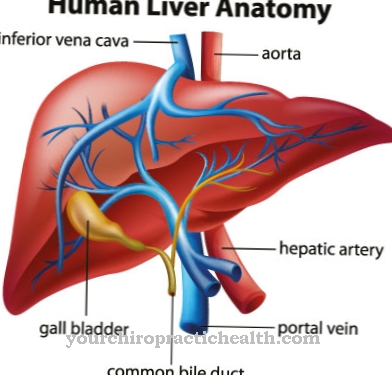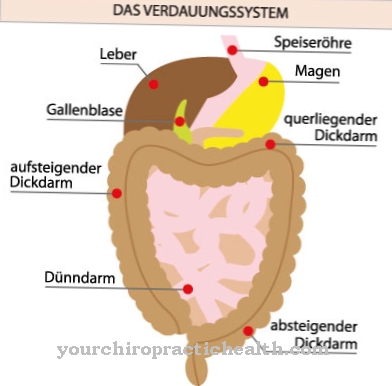The CRPS is a neurological-orthopedic-traumatological disease that occurs after a soft tissue or nerve injury. It is often associated with fractures of the extremities. The namesake of the older name for the CRPS type I, "Morbus Sudeck", is its discoverer, the Hamburg surgeon Paul Sudeck (1866 to 1945).
What is CRPS?

© jcomp - stock.adobe.com
CRPS (complex regional pain syndrome) is pain that occurs after an injury, i.e. post-traumatic. A distinction is made between two forms.
On the one hand, CRPS type I, which was previously also called algodystrophy, sympathetic reflex dystrophy or Sudeck's disease, and on the other hand, CRPS type II, which is also known as causalgia.
causes
The actual causes and the exact processes of a CRPS have not yet been fully clarified. In most cases, the symptoms occur after external influences such as accidents, inflammations or operations.
In some cases, however, the previous injuries are so minor that the victim has not even noticed them.There is no direct relationship between the development and extent of the syndrome and the extent of the injury. CRPS type I results from an injury without nerve involvement, while CRPS type II also affects the nerves.
Following the respective injury, there is a disruption in the healing process of the tissue, which is presumably related to the inflammatory reaction. There is likely to be an overproduction of inflammatory mediators that the body cannot break down quickly enough.
You can find your medication here
➔ Medicines for painSymptoms, ailments & signs
The course of CRPS is often very unspecific, especially at the beginning, and varies greatly from patient to patient. Based on the symptoms that occur, the course of the disease is often divided into three stages. However, since the stages can only rarely be clearly separated clinically from one another, this classification was largely abandoned.
At the onset of the disease, the affected extremity shows signs of inflammation with reddening, swelling (edema) and overheating of the skin. The main symptom is persistent pain that can no longer be explained by the previous injury alone. In many cases, there is also increased hair and nail growth and excessive sweating in the affected area.
As the disease progresses, the swelling will decrease. The skin becomes thinner and a sensation of cold develops in the extremity. There is increasing muscle weakness and restricted mobility, including stiffening of individual joints. Osteoporotic changes can appear in the bone.
The pain becomes more and more diffuse and the pain sensitivity of those affected increases. Many of the patients also suffer from tremor, an involuntary tremor of the affected extremity. Due to the high level of suffering and the mostly unsatisfactory treatment results, the patients are also psychologically stressed.
Diagnosis & course
Initially, the symptoms of CRPS are unspecific, which means they are often misinterpreted or carelessly dismissed. The diagnosis is primarily based on clinical criteria that correspond to the criteria established by the IASP (International Association for the Study of Pain) 2003 in Budapest.
The symptoms of CRPS are divided into four categories, with one symptom each from three of these four categories containing anamnestic (in the medical history) and symptoms from two of these categories must be detectable during the examination. Additional information can be obtained by means of apparatus-based methods. However, it is not possible to prove or rule out CRPS using apparatus diagnostics.
The complaints described by the person affected provide a first clue. Symptoms for CRPS type I are, for example, persistent, in most cases burning pain, hypersensitivity of the skin to pain, pain that extends beyond the nerve supply area, disorders of sweat secretion and blood circulation and the occurrence of edema.
Type II is through excruciating, glowing-burning pain that can be triggered or intensified by light touch, warmth, dryness, visual or acoustic stimuli or mere imagination of pain, circulatory disorders, disorders of the growth and nutritional state of the skin and one from the innervation area of the nerve independent pain spread.
The course of the disease can be very different from person to person. In mild forms, there may be spontaneous improvement after a few weeks. In more severe cases, the extent of the disease continues to grow and can ultimately become so severe that the affected patient's normal lifestyle can be severely restricted.
Complications
The CRPS usually leads to severe and chronic pain. This pain can occur in different areas of the body and also lead to swelling and redness on the body. It is not uncommon for pain to lead to depressive moods and other psychological complaints. Often the pain also occurs in the form of resting pain and leads to insomnia at night.
The everyday life of the patient is severely restricted by CRPS. The extremities feel warm and cramps can sometimes occur. It is not uncommon for the hands to tremble and the person affected suffers from paralysis and sensitivity disorders. These disorders can lead to considerable restrictions in everyday life and also to restricted mobility. The patient may also need help from other people in everyday life.
It is not uncommon for circulatory disorders to occur, so that extremities are undersupplied and in the worst case they die off completely. A direct causal treatment is usually not possible with CRPS. Treatment is therefore primarily aimed at reducing pain. There are no further complications. However, it is not possible to predict the further course of the disease.
When should you go to the doctor?
Unfortunately, the symptoms of CRPS are not particularly clear and meaningful, so that an early diagnosis and treatment of this disease is not possible in many cases. However, those affected should consult a doctor if they suffer from chronic and persistent pain. Reddening of the skin or swellings can also indicate the disease and should definitely be examined. Likewise, heated extremities can provide an indication of the disease.
If there is no treatment, those affected often suffer from tremors or cramps. If these symptoms occur more frequently and do not go away on their own, a medical examination is definitely necessary. A doctor should also be consulted in the event of paralysis or sensitivity disorders in order to avoid further complications from CRPS. The diagnosis is usually made by a general practitioner. Further treatment can then be carried out by a specialist. In the case of targeted pain in a specific region, a specialist can also be consulted directly.
Doctors & therapists in your area
Treatment & Therapy
The therapy for CRPS depends on the severity of the disease. Since there is no therapeutic approach that provides satisfactory results on its own, the possible measures are very broad.
In the first step, general therapeutic approaches are used. If its effect is not sufficient or if it becomes chronic, special pain therapy is necessary. Special specialists are responsible for this. If the clinical picture of type I is fully developed or if it is type II, a referral to a pain therapy specialist clinic, in which "continuous nerve blocks with catheters" are offered, is inevitable.
Experienced pain therapists can administer “sympathetic blocks” using therapeutic local anesthesia until hospitalization.
Outlook & forecast
Complete cure cannot be achieved with CRPS. For this reason, patients depend on long-term therapy to alleviate the symptoms. Above all, pain therapy is used to improve the quality of life of the person affected. However, the paralysis or sensitivity disorders can usually no longer be treated, so that those affected suffer from severe restrictions in their everyday life. CRPS often leads to severe psychological complaints or to depression.
If there is no treatment for CRPS, the symptoms and pain increase. Since patients often rely on strong painkillers, long-term use also damages the stomach. Whether the pain can be limited by pain therapy cannot be predicted here, since the further course depends very much on the exact severity of the disease. Often the patients suffer from the severe pain throughout their life.
The life expectancy of the person affected may also be significantly reduced as a result of the disease. However, this depends a lot on the exact cause of CRPS.
You can find your medication here
➔ Medicines for painprevention
Since it has been found that immobilizing the limb for too long is often the cause of CRPS type I, unnecessarily long splinting should be avoided and exercise therapy should be started as soon as possible. In addition, adequate pain therapy after surgery can prevent CRPS.
Aftercare
Follow-up care for CRPS is very difficult. Since there is no medical cure, the focus of aftercare is on reducing the symptoms. In this case there are many ways in which the sick can help themselves and improve their quality of life.
The self-healing powers of your own body can be enormous. A positive attitude is important for this. Positive thinking can improve the living situation as well as the actual symptoms. Since the complex regional pain syndrome occurs primarily in the limbs and the affected person suffers in most cases from inflammation of the skin and from movement and functional disorders, massages and targeted movement exercises can improve this situation.
The movement exercises should be adapted to which parts of the body are affected. Regular exercise in the affected areas of the body can reduce swelling and functional disorders. Applying heat and cold can also help reduce swelling and pain.
With these applications, the person concerned has to try out for himself whether heat or cold helps better. Heat applications can help in the form of warm baths, saunas, heat patches, etc. For a cold application, a cool pack, cooling sprays and a cold shower are recommended for local areas. Acupuncture can help relieve pain in CRPS. Acupuncture can clear blockages. The needles have a stimulating effect on the brain, which causes a large number of positive neurotransmitters to be released.
You can do that yourself
It is important that patients accept the diagnosis. This is the only way to provide meaningful therapy and to deal with it in everyday life. Therapy takes patience. So it is important to take your time and not fall into despair because there is no progress.
Persistent pain is a huge burden. These can definitely be reduced with a treatment by a pain therapist. The pain relievers may also decrease over time and the disease improves. The relatives can also support a successful therapy.
It is important that they are educated and know how to deal with a pain patient. Because persistent pain is a great psychological burden not only for the person affected, but also for the relatives. By understanding and working together on the disease, great success is achieved.
A complete cure is hardly possible, but an alleviation of the symptoms, also through cooperation with different doctors, is definitely likely. Positive thinking has been shown to help. There are several self-help groups in Germany with which patients can also exchange ideas online.






.jpg)

















.jpg)



